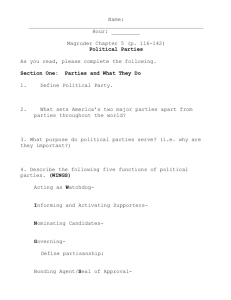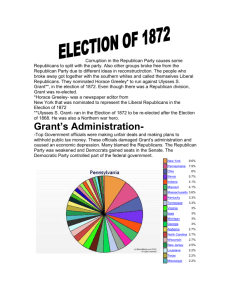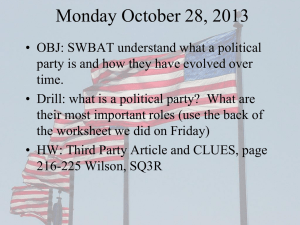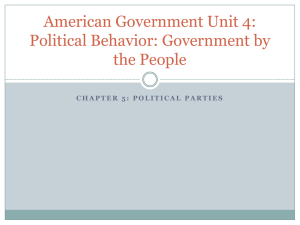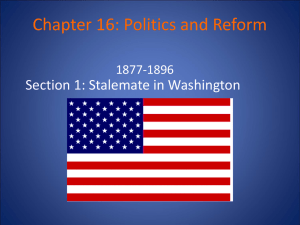Ch 5-3 The Two-Party System in American History
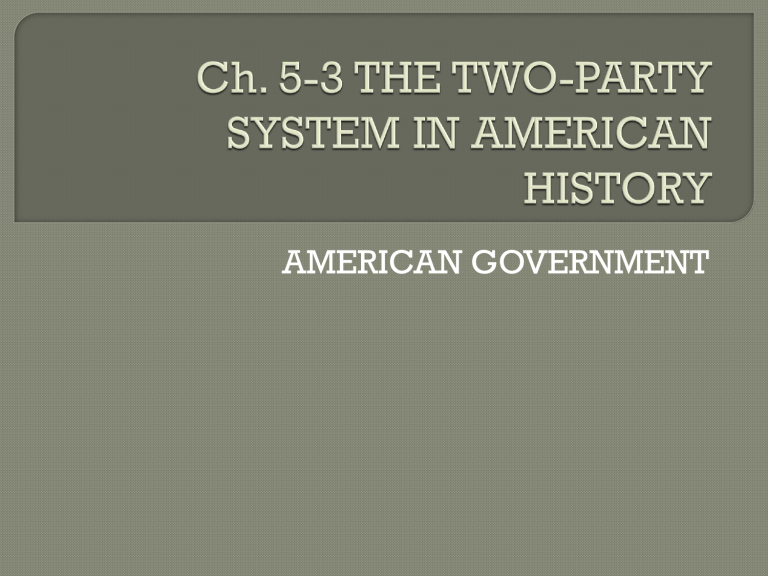
AMERICAN GOVERNMENT
Beginnings traced back to the ratification of the Constitution
The Federalist Party was the first to appear
Led by Alexander Hamilton
Viewed as the party of “the rich and wellborn”
Most supported the Constitution
Federalists worked to create a stronger national government
The opposition was led by Thomas
Jefferson
More sympathetic to the common man
Favored a very limited role for government
Congress should dominate
Its policies should help the nation’s small shopkeepers, laborers, farmers, and planters
Jefferson resigned from Washington’s cabinet in 1793 to concentrate organizing his party
Name: Anti-Federalists Jeffersonian
Republicans Democratic Republicans
(1828) Democratic Party
The Federalists and the Jeffersonian
Republicans clashed in the Election of 1796
John Adams (Fed) defeated Thomas
Jefferson (J-R) by just 3 votes
John Adams became President and Thomas
Jefferson became Vice President
Over the next 4 years Jefferson and Madison worked tirelessly to build their party.
Election of 1800—Jefferson defeats
INCUMBENT (current officeholder) Adams.
Jeffersonian Republicans also gain control of
Congress
Federalists never return to power
History of the American Party System can be divided into 4 major eras
I) THE ERA OF THE DEMOCRATS 1800-
1860
“Era of Good Feeling”
Democratic-Republicans were unopposed in national politics
By mid-1820s they had split into
FACTIONS (conflicting groups)
By the time of Andrew Jackson’s administration (1829-1837) a potent new party had risen to challenge the Democrats
National Republican (Whig) Party
Major issues—the Second National Bank of the USA, conflicts over public lands, high tariffs, and slavery
Democrats (Jackson) were a coalition of small farmers, debtors, frontier pioneers, slaveholders
Jacksonian Democracy produced 3 fundamental changes in the political landscape:
1) voting rights for all white males
2) a huge increase in the number of elected offices around the country
3) the spread of the spoils system—the awarding of public offices, contracts, etc. to those who supported the party in power
Whig Party led by Henry Clay and Daniel
Webster
Party consisted of a loose coalition of eastern bankers, merchants, and industrialists, plantation owners
Whigs a major party 1830s-1850s (along with the Democrats)
They elected only 2 presidents (both war heros) – William Henry Harrison (1840) &
Zachary Taylor (1848)
Slavery split both major parties
Deaths of Clay and Webster caused the
Whigs to fall apart
The new Republican Party (1854) drew many Whigs and antislavery Democrats
The Republicans nominated their first presidential candidate, John C. Fremont, in 1856
They elected their first President,
Abraham Lincoln in 1860
The Republican Party became the only party in history to make the jump from minor party to major party
II) THE ERA OF THE REPUBLICANS 1860-
1932
Civil War Signaled the beginning of the
Republican Era
Support from business, financial interests, farmers, laborers, and newly freed African
Americans
Democrats crippled by the war
Survived because of their hold on the “solid south”
Only 1 Democratic President—Grover
Cleveland in 1884 & 1892
The Election of 1896 promoted the 2-party system
William McKinley(R) vs. William Jennings
Bryan (D)
McKinley supported the gold standard while Bryan supported free silver
McKinley wins the election
Republicans draw support from wide portion of the ELECTORATE (people eligible to vote).
Republicans remain dominant for another
3 decades.
William Jennings Bryan campaigned for the “little man”
He pushed party politics back toward economics and away from sectionalism
Worst Republican setback of the era—
1912
President William Howard Taft (R) vs.
Woodrow Wilson (D) vs. Former President
Theodore Roosevelt (R-Bull Moose
Progressive)
Republican vote split between Taft &
Roosevelt
Wilson wins the election and ends up serving 2 terms
Wilson’s win was lucky
Republicans would win in 1920(Harding),
1924(Coolidge), 1928(Hoover)
III) THE RETURN OF THE DEMOCRATS
1932-1968
The Great Depression (1929) had a massive impact on all aspects of
American Life
Franklin D. Roosevelt (D)elected
President in 1932
Election marked a basis shift in the public’s attitude toward government
Roosevelt won with a new electoral base
Southerners, small farmers, organized labor, big-city political organizations
Revolutionary economic and social welfare programs – New Deal (1930s)
Support also came from African-
Americans and other minorities
FDR won re-election in 1936, 1940, 1944 – each time by heavy majorities
Vice President Harry S. Truman became
President in 1945 upon FDR’s death
Truman won his own term in 1948
Republicans won in 1952 & 1956 under
WWII hero Dwight D. Eisenhower
John F. Kennedy regained the White
House for the Democrats in 1960 with a thin victory over Republican Richard M.
Nixon
Lyndon B. Johnson became President when JFK was assassinated in 1963
LBJ won his own term in 1964.
IV) THE START OF A NEW ERA
Richard Nixon(R) became President in
1968
The Vietnam war split the Democratic
Party.
Nixon faced strong opposition from
Hubert Humphrey (D) and Governor
George Wallace (AL-American Ind.)
Nixon won by a small plurality
Nixon re-elected in 1972
Nixon’s role in the Watergate Scandal forced him to resign in 1974
Vice President Ford finished Nixon’s term until 1976
Ford pardoned Nixon
1976-Ford ran against GA Governor Jimmy
Carter(D). Carter won.
Carter couldn’t get the economy moving and there was fallout from the Iranian
Hostage Crisis in 1979-1980
Republicans scored impressive victories in1980 (over Carter) & 1984 (over VP
Mondale) with former CA Governor and actor Ronald Reagan
1988—Former VP George H.W. Bush (R) keeps the Republicans in power
1992—AR Governor Bill Clinton (D) wins the first of two terms by defeating Bush and Independent Ross Perot
The Election of 2000—George Bush(R) vs.
Al Gore (D)
Bush did not win the popular vote but he did have more electoral votes
2004—Bush defeats John Kerry (D)
2008—Barak Obama (D) defeats John
McCain (R)
Coattails—candidates with same party as the president also tend to win
The end
